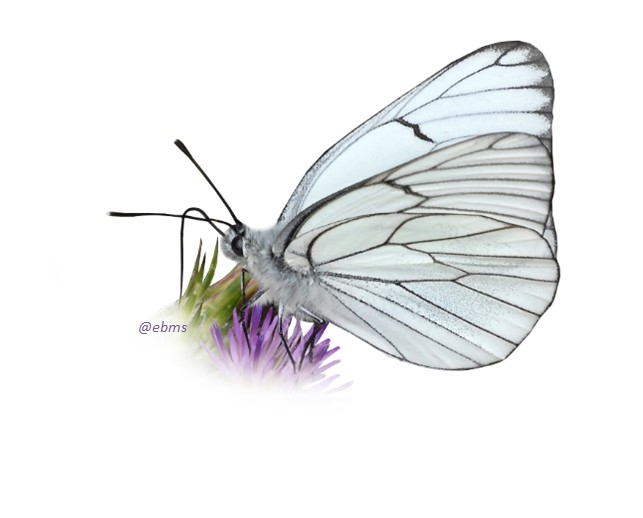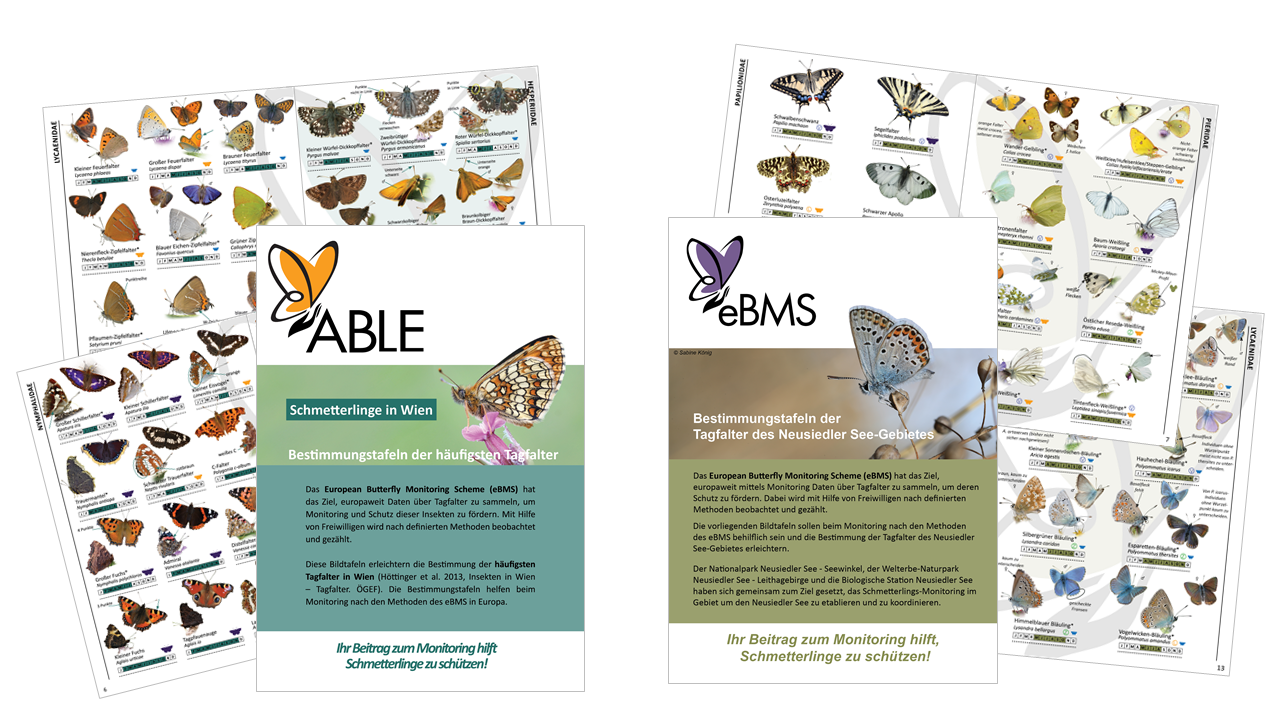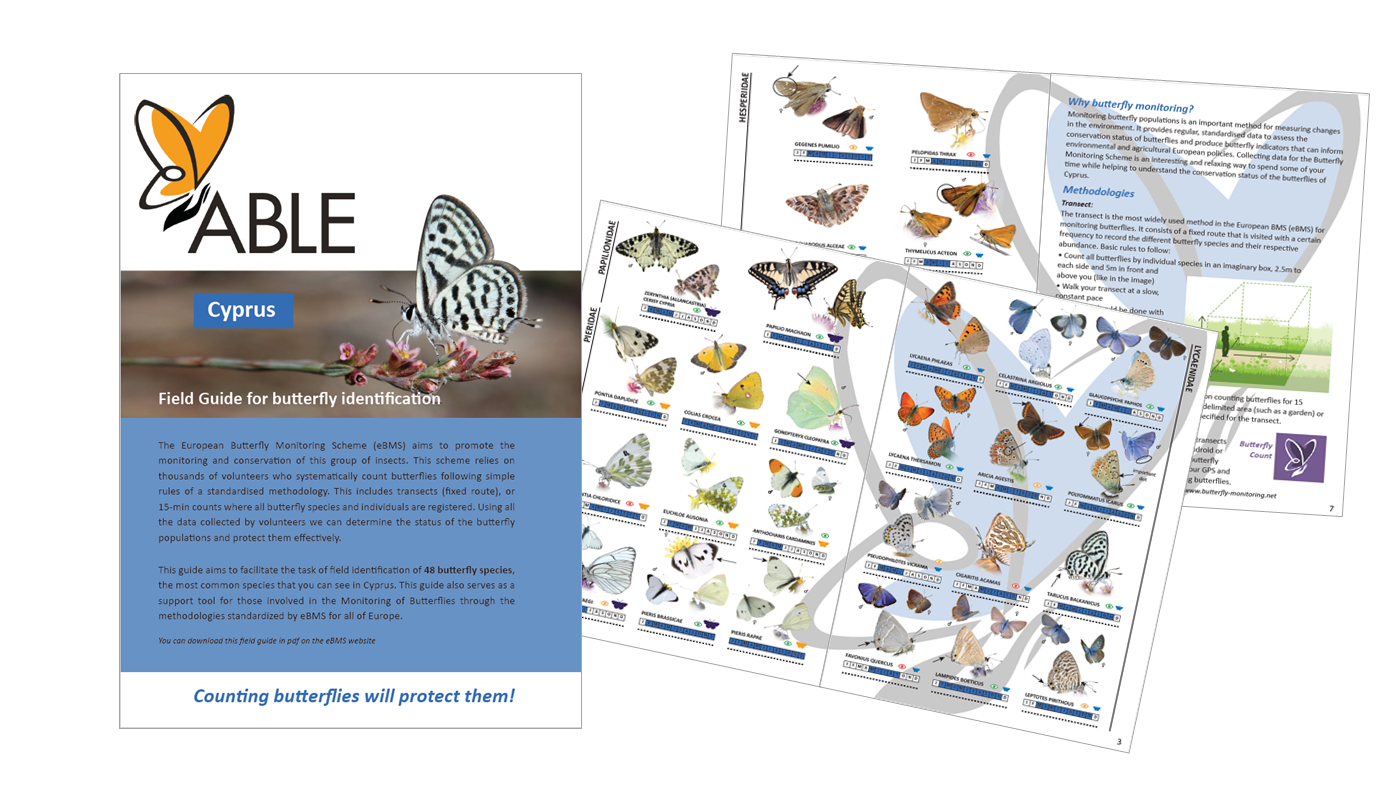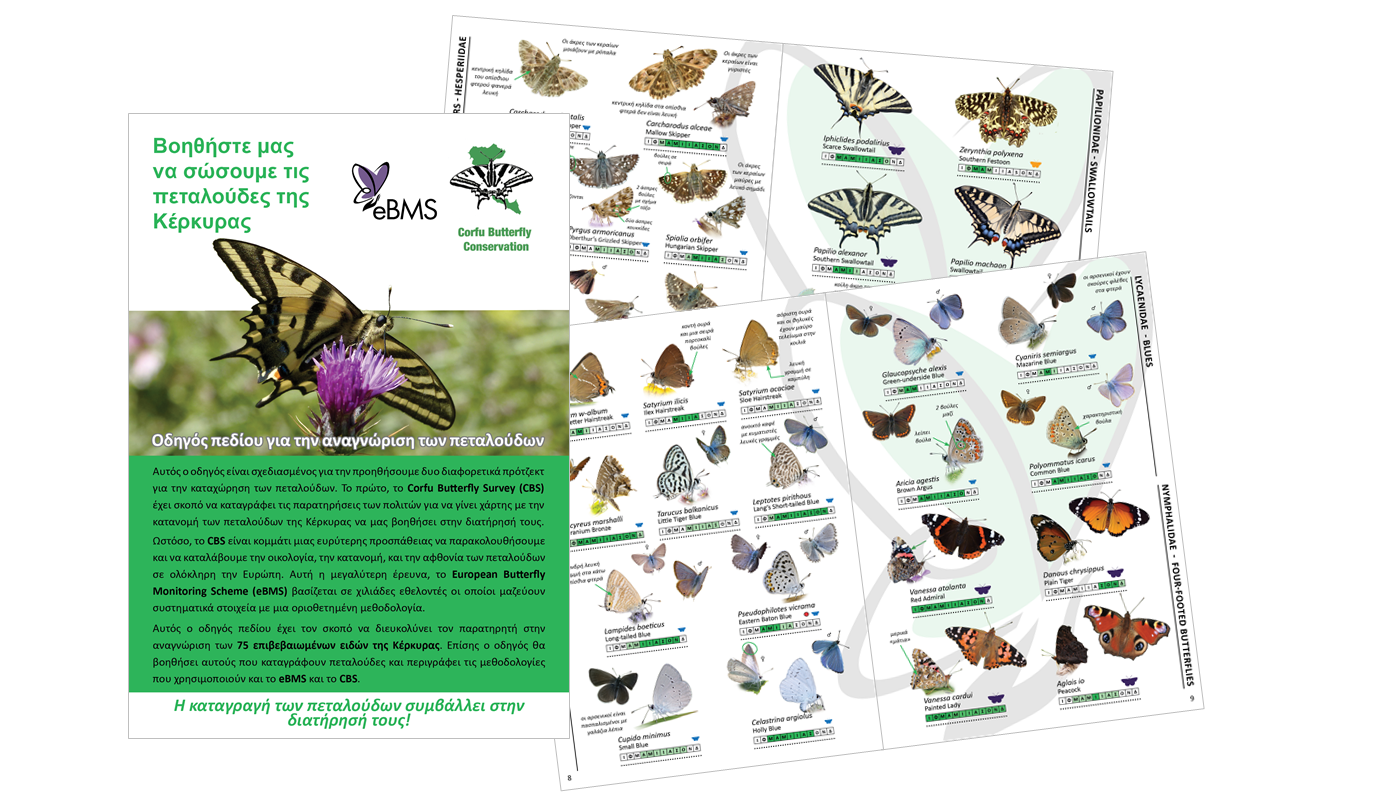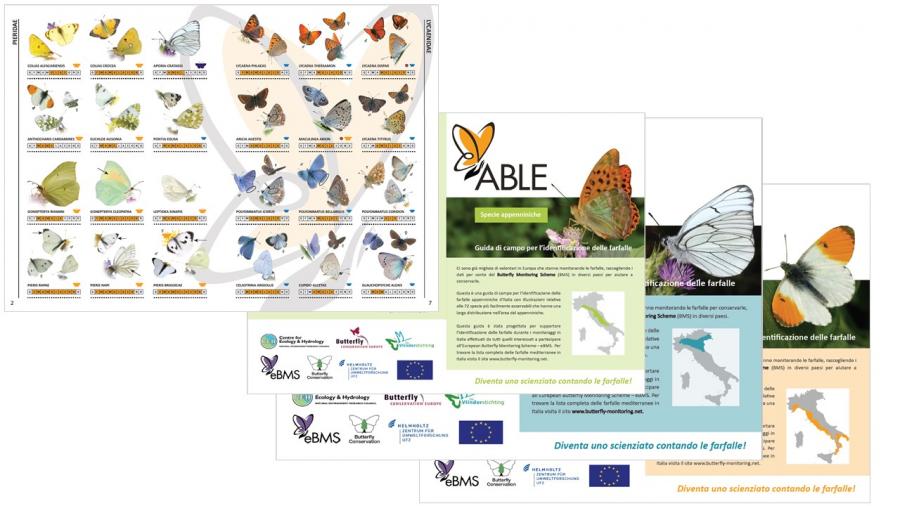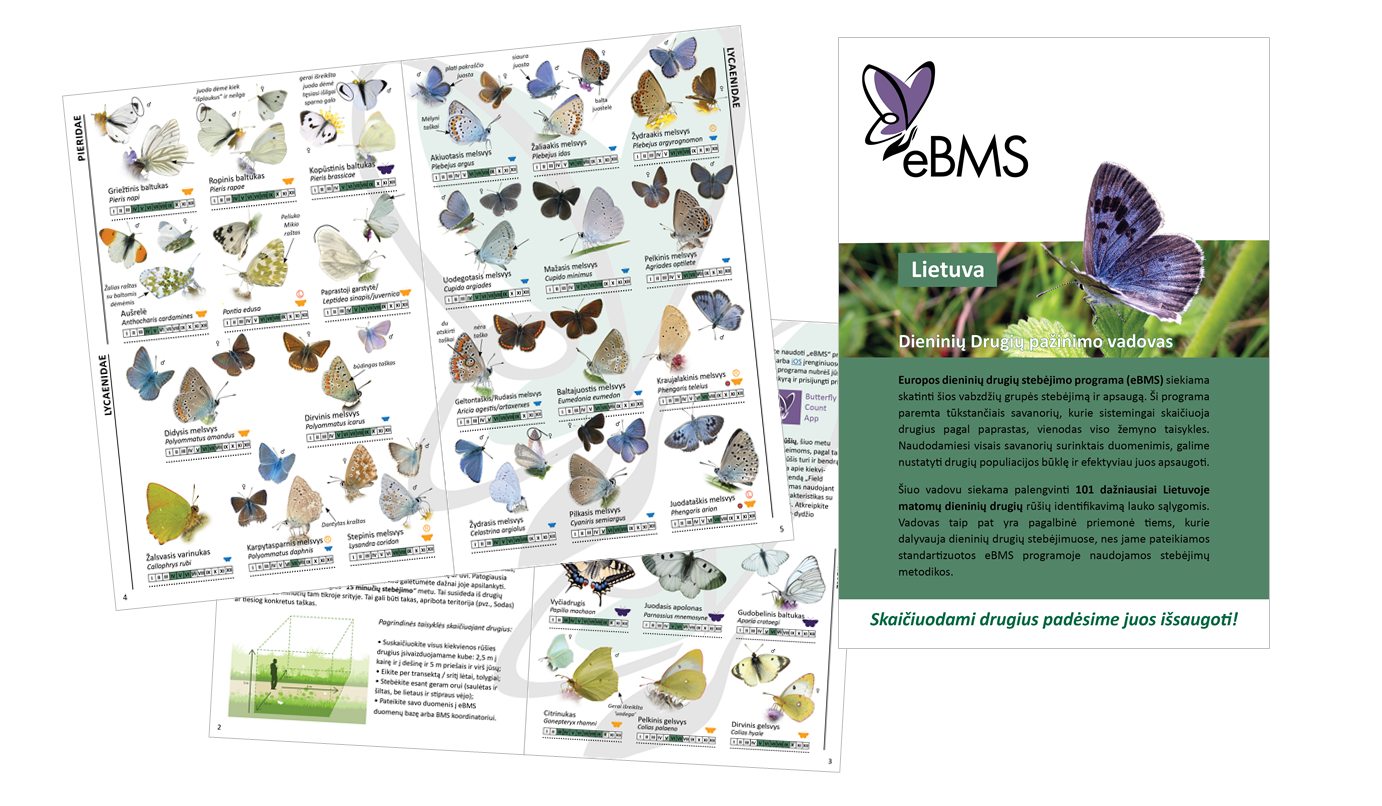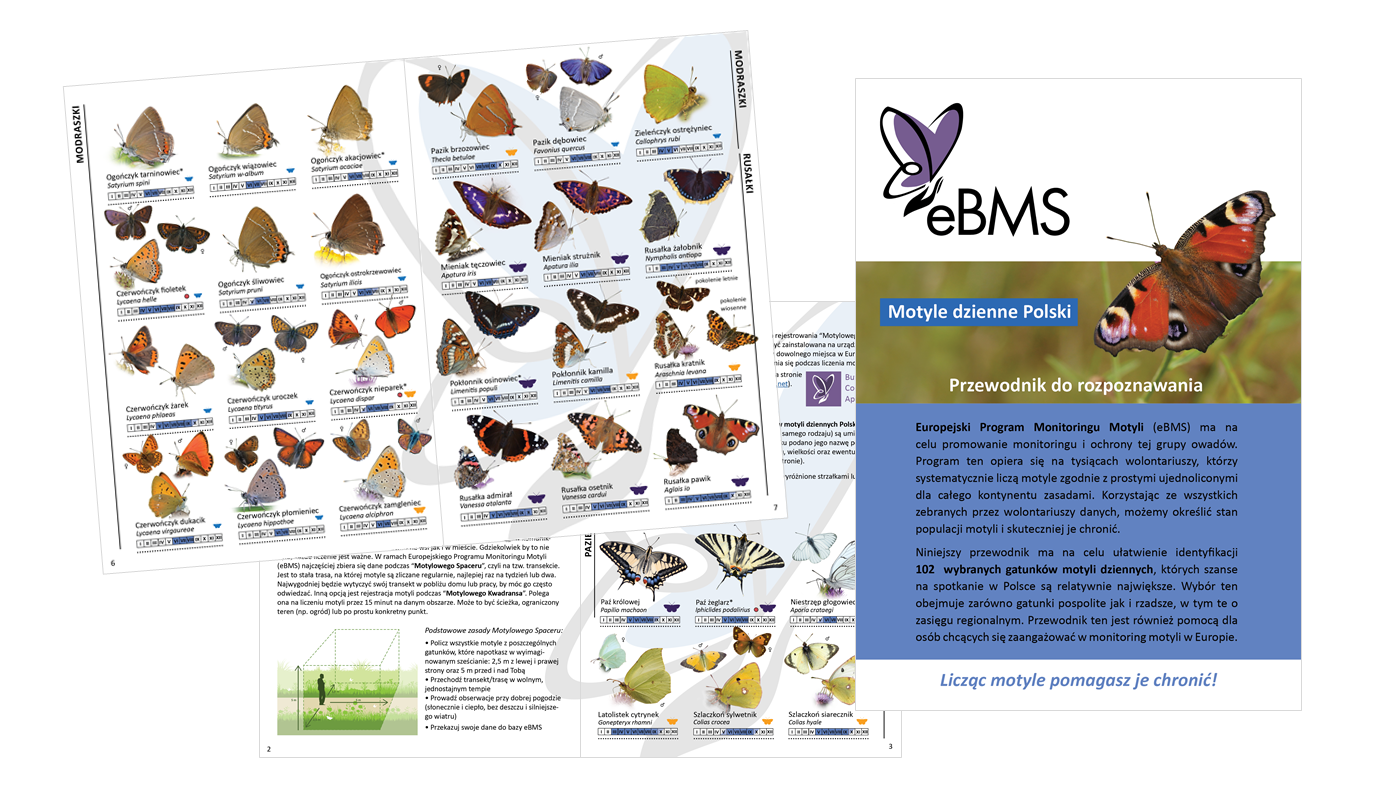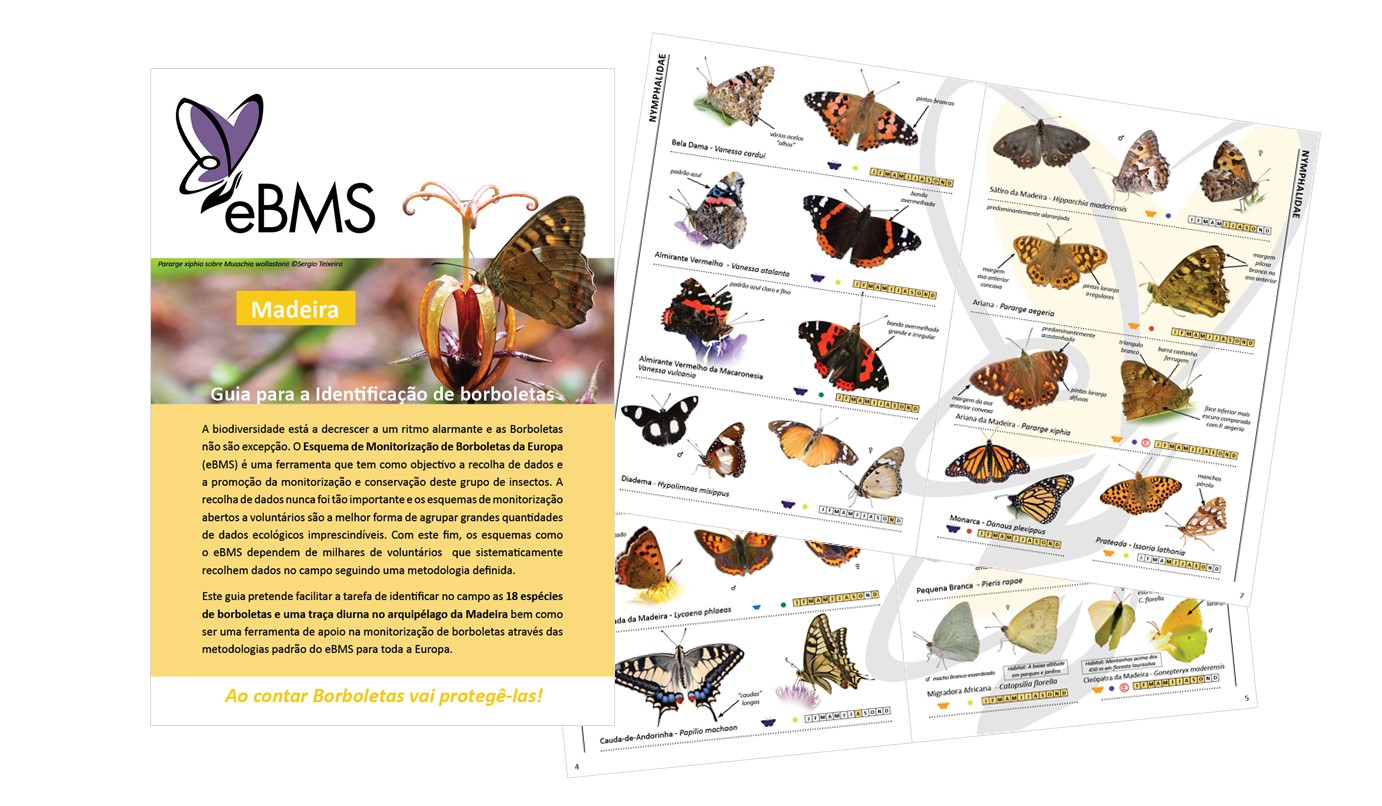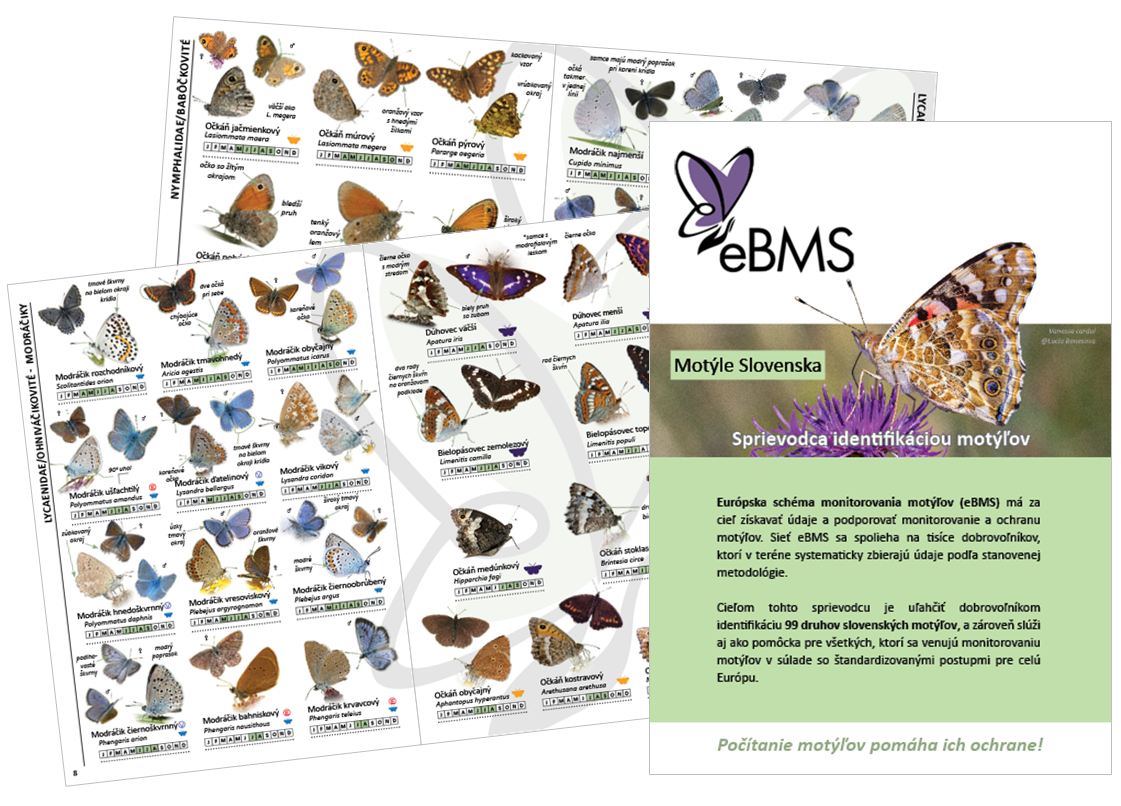Guide di campo per l'identificazione delle farfalle
Le guide da campo di eBMS vogliono essere utili per identificare le farfalle sul campo in modo facile e semplice. Le specie di farfalle sono organizzate per famiglie e generi e ci sono simboli che identificano caratteristiche utili per identificare facilmente le specie di farfalle.
Puoi scaricare sui tuoi dispositivi e stampare tutte queste guide da campo gratuite
Abbiamo selezionato le specie più comuni per regione riducendo il numero di specie in ogni guide da campo con l'aiuto di esperti di farfalle e coordinatori BMS. Questo materiale utile aiuterà i volontari e coinvolgerà le persone nel monitoraggio delle farfalle. Guarda qui sotto le diverse Field Guide create per paese o regione e scarica i pdf in diverse lingue. Ci sono guide sul campo per:
- Austria - Vienna
- Cipro
- Italia
- Lituania
- Malta
- Polonia
- Portogallo - Madeira
- Slovenia
- Slovacchia - specie comune
- Spagna - Andalusia e Castilla-La Mancha
Austria
Two different field guides to identifying the most common butterfly species in the area. These Guides aim to be useful for identifying butterflies of a certain area in the field in an easy and simple way. Butterflies are divided into families, presenting symbols to mark specific characteristics with which to identify them and with information about ease to see them. Also, this Guide includes an explanation of the methodologies to monitor butterflies (transects and 15-min Counts).
- Field Guide Vienna: You can download the pdf guide (in German) directly to your device or print it directly (select the booklet option in the printer). You could find the 100 most common butterfly species in Vienna.
- Field Guide Lake Neusiedl Region: You can download the pdf guide in German and in English directly to your device or print it directly (select the booklet option in the printer). You could find in this field guide more than 100 butterfly species most common in the area around Lake Neusiedl in Burgenland.
Cyprus
A field guide to identify 48 of the most common butterfly species in Cyprus. This Guide aims to be useful for identifying butterflies in the field in an easy and simple way. Butterflies are divided by families, present symbols to mark specific characteristics with which to identify them and with information about ease to see them. Also, this Guide includes an explanation of the methodologies to monitor butterflies (transects and 15-min Counts).
You can download the pdf guide Field Guide Cyprus directly to your device or print it directly (select the booklet option in the printer).
Greece - Corfu
A field guide to identify +75 butterfly species occurring in Corfu, Greece. This Guide aims to be useful for identifying butterflies in the field in an easy and simple way. This Field Guide has been done in collaboration between Corfu Butterfly Conservation and Butterfly Conservation Europe and funded by the Rothschild Foundation for printing. You can download the pdf guide Field Guide Corfu directly to your device or print it directly (select the booklet option in the printer), and it comes in an English and a Greek version (translated by Anne Sordinas):
Italy - per regions
Many countries in Europe are very rich in butterfly species and identifying butterflies is a real challenge. In Italy, there are around 290 species and the lack of identification guides was a problem. Together with the Italian Butterfly Group we divided Italy into climatic regions and selected the 72 most common species in each climatic area. We eventually produced 4 different Field Guides from specific regions: Padana plain, Mediterranean area, Apennines and Mediterranean Islands.
You can download the guides from here and print them directly.
- Field Guide Regione Padana Plain (Italiano), version inglese updated 2023
- Field Guide Apennines region (IT)
- Field Guide Regione Mediterranean (Italiano), version inglese updated 2024
- Field Guide Mediterranean Islands (IT)
Field Guides from Natural/National Parks:
Lithuania
A field guide to identify 101 most common butterfly species in Lithuania. This Guide aims to be useful for identifying butterflies in the field in an easy and simple way. Butterflies are divided by families, present symbols to mark specific characteristics with which to identify them and with information about ease to see them. Also, this Guide includes an explanation of the methodologies to monitor butterflies (transects and 15-min Counts).
You can download the pdf directly to your device or print it directly (select the booklet option in the printer):
Malta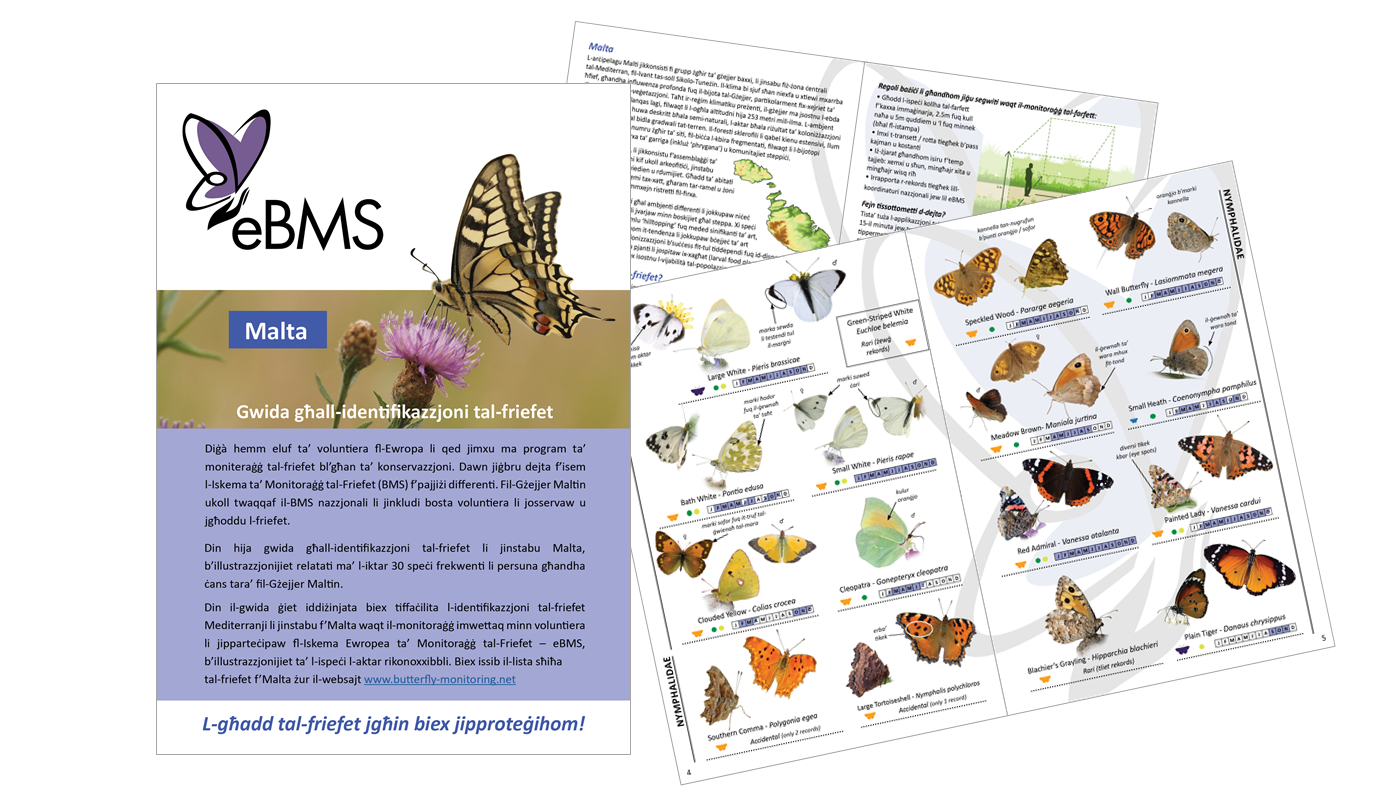
A field guide to identify 30 butterfly species in Malta, with illustrations of the more recognizable species. This Guide aims to be useful for identifying butterflies in the field easily and simply. Butterflies are divided by families, presenting symbols to mark specific characteristics with which to identify them and with information about ease to see them. Also, this Guide includes an explanation of the methodologies to monitor butterflies (transects and 15-min Counts).
You can download the pdf guide Field Guide Malta directly to your device or print it directly (select the booklet option in the printer) in two languages:
Poland
This guide aims to facilitate the identification of 102 selected species of butterflies, with the highest probability of finding them in Poland. This selection covers both common and rare species, including those with a regional range. This guide is also a help for those wishing to get involved in butterfly monitoring in Europe.
You can download the pdf guide Field Guide Poland (in Polish) directly to your device or print it directly (select the booklet option in the printer).
Portugal - Madeira
Madeira is a group of volcanic islands located west of Northwest Africa. These evergreen forests and thickets are in fact the dominant habitat on the island, known as “laurissilva”, the Laurel forests. These botanical communities are the main habitat for most endemic butterfly species.
A field guide to identify 18 butterfly species occurring in Madeira, including 4 endemic species. This Guide aims to be useful for identifying butterflies in the field in an easy and simple way for citizens. Also, this Guide includes an explanation of the methodologies to monitor butterflies (transects and 15-min Counts).
You can download the pdf directly to your device or print it directly (select the booklet option in the printer):
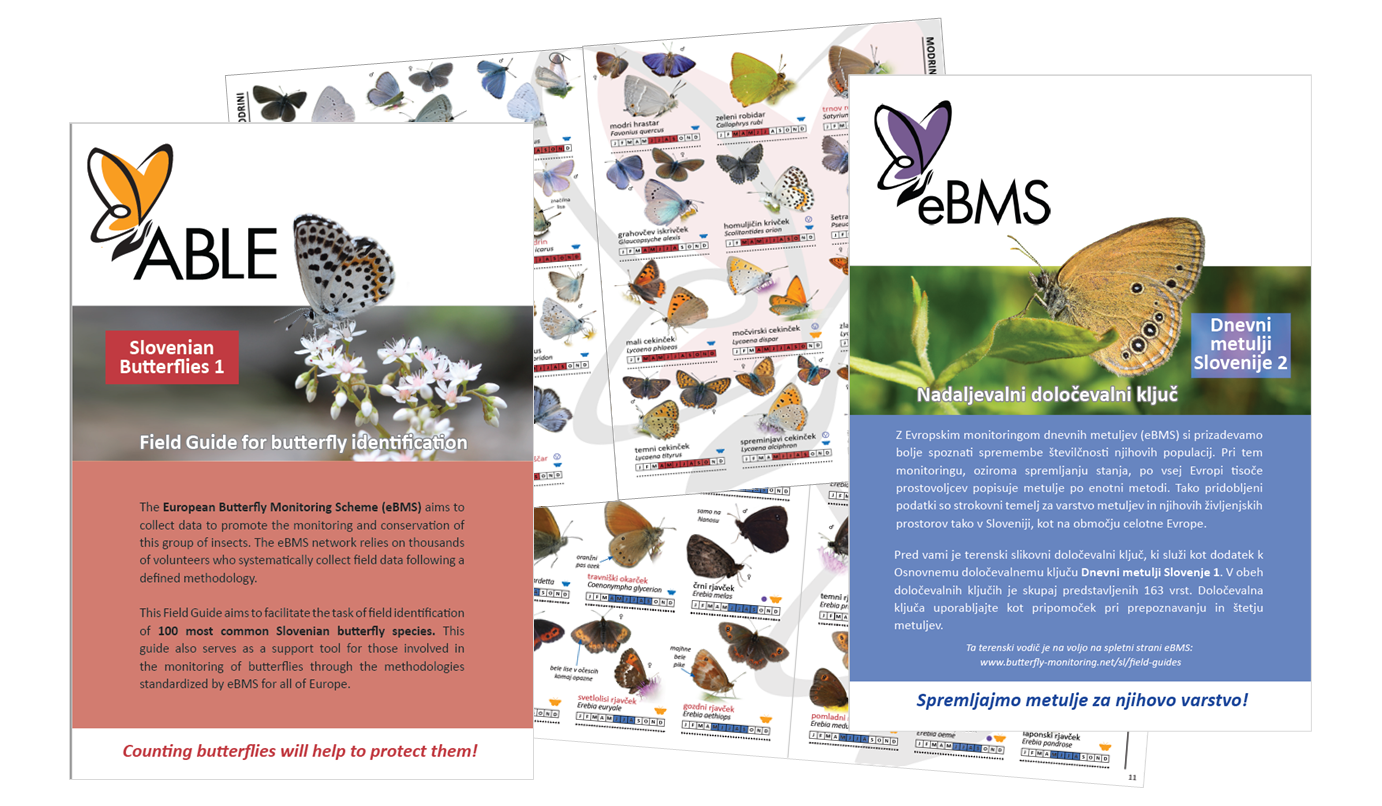 Slovenia
Slovenia
The species diversity of Slovenian butterflies is extremely high concerning the area of the country. A total of 181 species of butterflies live in Slovenia. eBMS created two field guides together with Slovenian experts to provide a useful and practical resource to bring to the field. You can find the Slovenian Butterflies 1 showing pictures to identify 100 butterfly species that occur more frequently in diverse ecosystems of Slovenia. This easy and direct Field Guide will help volunteers in butterfly identification and it provides the link (name species in red) to the Field Guide, Slovenian Butterflies 2, with species links between more difficult and similar species.
- You can download the Slovenian Butterflies 1 in pdf directly to your device or print it directly (select the booklet option in the printer): Slovenian 1 version and English 1 version
- To complete your knowledge of Slovenian butterflies, you can download Slovenia Butterflies 2 which presents 63 species difficult to identify or locally widespread and another 37 species more common and related in red to the Field Guide Slovenia 1. Download this Field Guide in Slovenian 2 version and English 2 version.
Slovakia
This guide aims to facilitate the identification of 99 more common butterfly species with the highest probability of finding them in Slovakia. This selection covers both common and rare species, including those with a regional range. This guide is also a help for those wishing to get involved in butterfly monitoring in Europe.
You can download the pdf guide Field Guide of Slovakia directly to your device or print it directly (select the booklet option in the printer).
Spain
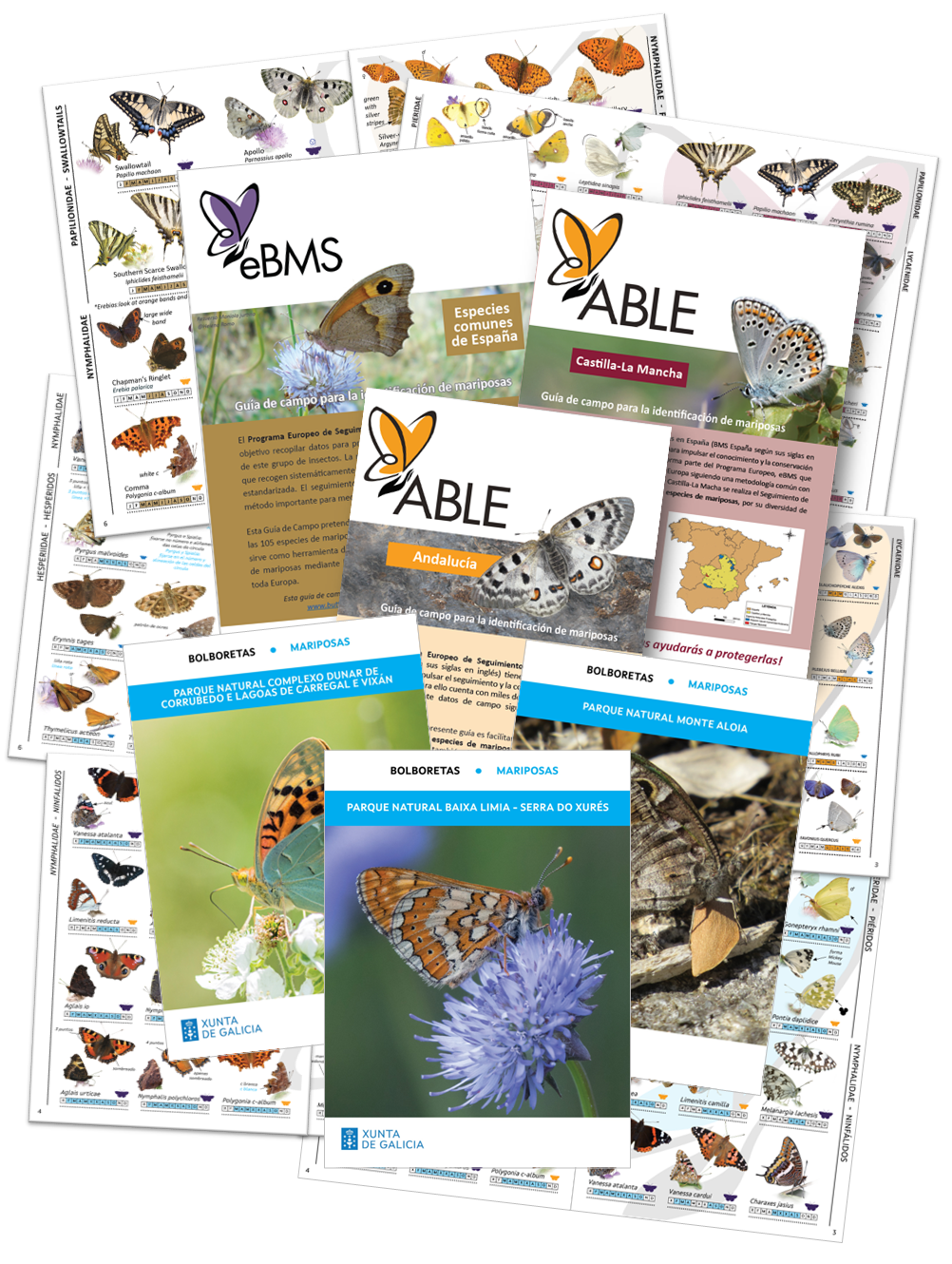 Common species Spain
Common species Spain
Spain is a diverse country with different climatic zones where there are at least 258 butterfly species; great diversity, and challenge to monitor. For that reason, a new Field Guide of the Spanish Common Species has been created to facilitate the identification of the 105 most common species in the country, including Canary species. Like the rest of the Field Guides, you can find a nice and logical order of the species, pointing and highlighting important characteristics to identify properly the species.
Andalucía
This Field Guide includes 93 of the most common butterfly species in Andalusia in just 12 pages. This Guide aims to be useful by reducing the number of butterflies in an area as rich and diverse as Andalusia, a Mediterranean area with an African influence and with peculiar endemisms. You can download the guide in pdf in various formats:
- Andalusia Guide (Spanish): to print directly, Andalusia guide by pages (Spanish): pdf with individualized pages to download to your device or print
- Andalusia Guide (English): to print directly, four sheets are to be printed on both sides, and the pages are ordered for printing.
Castilla-La Mancha
Castilla-La Mancha is a region of the peninsular center of Spain with a great diversity of ecosystems. It has a big number of butterfly species, with a total of 157 species in the whole region, being the 67,4% of the peninsular total. You can see the Complete list of butterflies species from Castilla-La Mancha (CLM) in this pdf. You can download the CLM Field Guide guide in pdf format with the 72 most common butterfly species in CLM in 8 pages.
- CLM Guide (Spanish): two sheets to be printed on both sides,CLM Guide by pages (Spanish): pdf of individualized pages to download to your device or print
- CLM Guide by pages (English): pdf English version of individualized pages to download to your device or print
Galicia
You can now download the butterfly identification booklets that we have designed for the BMS implementation project in the Natural Parks of Galicia on its website: https://patrimonionatural.xunta.gal/es
- Parque Natural do Monte Aloia
- Parque Natural Baixa Limia-Serra do Xurés
- Parque Natural Complexo dunar de Corrubedo e lagoas de Carregal e Vixán
How to print the Field Guides:
If you select the pdf with 4 pages which you can print in two sheets for both sides. The order of the pages is organised to print them directly. When you have the two sheets printed, just fold the sheets for the middle and organise them following the number of the pages.
If you select the pdf by individual pages, you can print directly the Field Guide by selecting the booklet option in the printer.
Acknowledgments to Paolo Mazzei, Marco Bonifacino, Raniero Panfili y Daniel Morel (www.leps.it); Javier Olivares, Jose Miguel Barea, Félix Loarte García, Juan Pablo Cancela, Mariano Vindel, José Rodrigo Dapena, Rafael Pérez Fernández, Christodoulos Makris, Christos Zoumides, Hasan Bağlar, Kelebek Gözlemi, Akturk Pilanci, Elli Tzirkalli, Luka Šturm, dr. Rudi Verovnik, Barbara Zakšek, Primož Glogovčan, Nika Kogovšek; Izabella Dziekanska, Marcin Sielezniew, Giedrius Švitra, Carlos Viveiros, Sergio B. Marques Teixeira, Martin Wiemers, Klaus Frischkorn, António Aguiar, Matt Rowlings, Peter Verhelst, Wim Declarecq, Andreas Pospisil, Lucia Benešová, Albert Vliegenthart, Guido Bonett, Aldo Catania, and Chris van Swaay for providing pictures for the creation of the Field Guides. Also, to the designer who created the different butterfly shapes from pictures, Eveline van der Jagt and the edition by Cristina G. Sevilleja.

